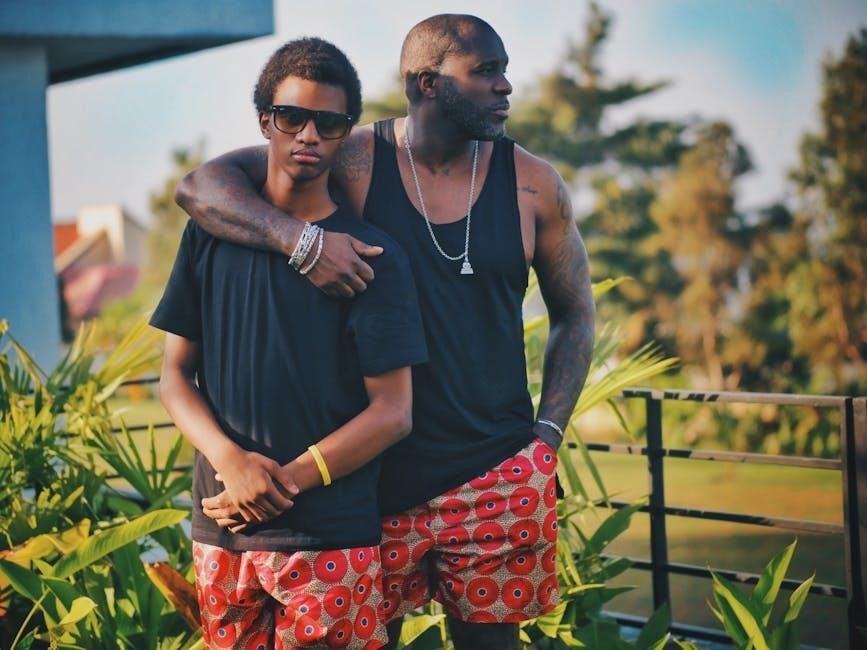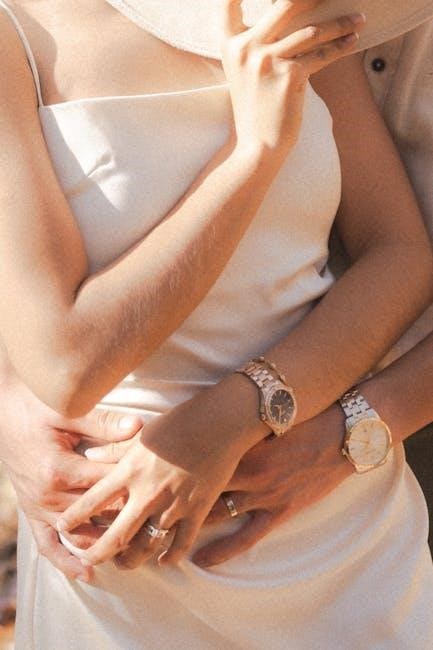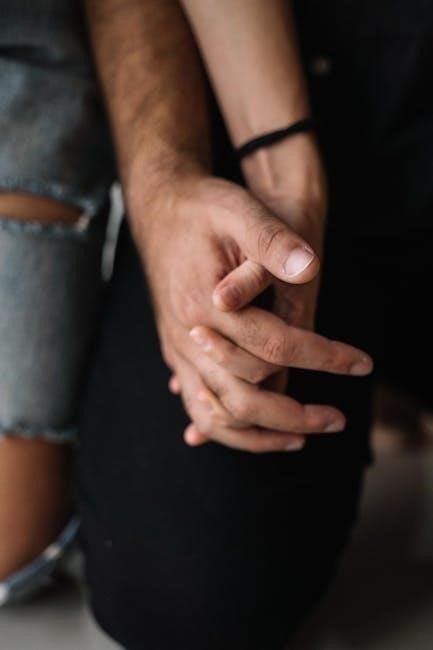Discover the ultimate guide to men’s bracelet sizes. Learn how to measure your wrist, choose the perfect fit, and enhance your style with confidence and precision.
1.1 Importance of Proper Fit in Men’s Bracelets
A proper fit is essential for comfort and style. A bracelet that’s too tight can cause discomfort, while one that’s too loose may slip off. Ensuring the right size enhances both aesthetics and functionality, making the bracelet a perfect accessory for any occasion.
1.2 Brief Overview of Bracelet Size Measurement
Bracelet size measurement involves determining the circumference of your wrist using a flexible tape measure or alternative tools. This process ensures a comfortable fit, with the bracelet neither too tight nor too loose. Accurate measurement is crucial for selecting the right size, enhancing both comfort and style. Standard sizes typically range from 7 to 10 inches.

How to Measure Your Wrist for a Bracelet
Measuring your wrist ensures a perfect fit; Use a flexible tape measure around the widest point, typically including the bone. This step is essential for accurate sizing.
2.1 Using a Flexible Measuring Tape
A flexible measuring tape is ideal for wrist measurement. Wrap it snugly around the widest part, ensuring comfort and accuracy. This method provides precise circumference, essential for selecting the correct bracelet size. Proper alignment and a relaxed wrist position are key to reliable results. Use this technique for all bracelet types, including leather, chain, and cuff styles. Accurate measurement ensures a perfect fit.
2.2 Measuring the Widest Point of the Wrist
To ensure accuracy, measure the widest part of your wrist, typically where a watch would sit. Place the tape measure or string horizontally, keeping it level and not too tight. This circumference will guide you in selecting the correct bracelet size from the chart, ensuring a comfortable and secure fit.
2.3 Alternative Methods for Wrist Measurement
If a tape measure isn’t available, use a string or paper strip. Wrap it around your wrist at the widest point, mark where it overlaps, and measure the length with a ruler. Digital tools or apps can also provide precise measurements, ensuring accuracy without traditional tools. This method is quick and effective for determining your bracelet size.
Understanding Men’s Bracelet Size Charts
Standard men’s bracelet sizes range from 7 to 10 inches. Charts typically include wrist circumference and corresponding bracelet lengths, ensuring the perfect fit for any style or material.
3.1 Standard Size Ranges for Men’s Bracelets
Men’s bracelets typically range from 7 to 10 inches in circumference. The most common sizes are 8-9 inches, ensuring comfort and style. Smaller wrists may prefer 7-8 inches, while larger wrists opt for 9-10 inches. These standard ranges help in selecting the ideal fit for various bracelet types and materials, ensuring both comfort and aesthetics are maintained.
3.2 How to Interpret the Size Chart
Match your wrist measurement to the size chart to find your ideal bracelet size. Ensure the bracelet is neither too tight nor too loose for comfort. If your measurement falls between sizes, consider the style and material to decide. This step ensures a perfect fit, balancing aesthetics and comfort effectively for any men’s bracelet style.
3.3 Factors Influencing Bracelet Fit
Wrist size, bracelet style, and material impact fit. Chain bracelets may require more precise measurements, while cuffs offer flexibility. Material adjustability, like metal or leather, also affects comfort. Personal preference for tightness or looseness plays a role. Consider these factors to ensure the bracelet sits comfortably and complements your style without restricting movement.

Popular Styles of Men’s Bracelets and Their Size Requirements
Explore popular men’s bracelet styles, such as leather, chain, and cuff. Each style has unique size requirements, ensuring a perfect fit for every wrist.
4.1 Leather Bracelets: Size Considerations
Leather bracelets offer a classic look and are generally adjustable. Measure your wrist at the widest point, typically between 7.5 to 9 inches for men. Choose a size that allows a snug fit without being too tight, as leather stretches slightly over time. Consider adjustable closures for a customizable fit, ensuring comfort and style.
4.2 Chain Bracelets: Measuring for the Perfect Fit
Chain bracelets require precise measurement for optimal comfort. Measure your wrist at the widest point, typically between 7.5 to 9 inches for men. Choose a length that allows the chain to drape comfortably without being too tight or loose. Consider the thickness of the chain, as thicker styles may need a slightly longer length for a balanced fit.
4.3 Cuff Bracelets: Sizing Tips
Cuff bracelets, with their open design, require careful sizing for comfort. Measure the widest part of your wrist to ensure the cuff fits snugly but not tightly. Choose a size that allows the bracelet to slip on and off easily. Consider the material and style, as thicker cuffs may need a slightly larger size for optimal fit and aesthetics.

Materials and Their Impact on Bracelet Size
Different materials affect bracelet sizing. Metal bracelets may require precise fits, while leather or fabric styles offer flexibility. Beaded designs often accommodate various wrist sizes naturally.
5.1 Metal Bracelets: Adjustability and Sizing
Metal bracelets often feature adjustable clasps or links, allowing for precise sizing. Measure your wrist circumference to ensure a snug fit, as metal styles typically offer less flexibility than leather or fabric designs. Standard sizes range from 7.5 to 9 inches, with 8 inches being the most common. Ensure the bracelet sits comfortably without being too tight or loose for the best look and feel;
5.2 Beaded or Gemstone Bracelets: Flexibility in Fit
Beaded or gemstone bracelets offer natural flexibility, making them adaptable to various wrist sizes. Their elastic or cord-based designs allow for a snug yet comfortable fit without the need for adjustable clasps. Measure your wrist to align with standard sizes (7.5–9 inches) and ensure the bracelet isn’t too tight or loose. Opt for styles that complement your wrist’s proportions for a balanced look.
5.3 Fabric or Cord Bracelets: Elasticity and Size
Fabric or cord bracelets are highly versatile due to their elasticity. These styles stretch to fit various wrist sizes, offering a snug, comfortable fit. They are ideal for those with wrists between 7-9 inches. To choose the right size, measure your wrist and select a cord length that aligns with standard charts. This ensures a secure, stylish fit without compromising comfort or appearance.
How to Choose the Right Bracelet Length
Choosing the right bracelet length involves measuring your wrist and considering personal style. Opt for a length that complements your wrist size for a balanced, comfortable fit.
6.1 Understanding Wrist-to-Bracelet Length Ratio
The wrist-to-bracelet length ratio ensures a proportional fit. Measure your wrist circumference and match it to a bracelet length that complements your size. For example, a 7-inch wrist pairs well with a 7.5 to 8-inch bracelet, ensuring comfort and style without being too tight or loose, creating a balanced look.
6.2 General Guidelines for Bracelet Length
Standard men’s bracelet lengths typically range from 7.5 to 9 inches, with 8 inches being the most common size. This measurement correlates with wrist circumference, ensuring a comfortable and stylish fit. For smaller wrists, opt for 7.5-inch bracelets, while larger wrists suit 8.5 to 9-inch styles. Choosing the right length ensures your bracelet sits comfortably without sliding too far up or down your arm.
6.3 Adjusting Bracelet Length for Personal Preference
While general guidelines suggest standard lengths, personal preference plays a significant role. Some prefer a snug fit for durability, while others opt for a looser style for comfort. Adjustments can be made by choosing slightly shorter or longer lengths based on individual comfort and lifestyle needs, ensuring the bracelet complements both functionality and personal style seamlessly.

International Size Charts for Men’s Bracelets
Explore global sizing standards for men’s bracelets, comparing US, EU, and UK measurements. These charts provide universal references, ensuring a perfect fit regardless of regional sizing differences or preferences.
7.1 Comparing US, EU, and UK Bracelet Sizes
US, EU, and UK bracelet sizes differ slightly due to measurement standards. The US typically uses inches, while the EU and UK prefer centimeters. For example, a 7.5-inch bracelet is about 19 cm, fitting both EU and UK sizing charts. These comparisons help ensure accurate sizing, making international shopping easier for men seeking the perfect bracelet fit globally.
7.2 Converting Measurements Across Different Standards
Converting bracelet measurements between US, EU, and UK standards requires understanding their systems. For example, a 7.5-inch bracelet in the US is approximately 19 centimeters in EU/UK sizing. Use a conversion formula: multiply inches by 2.54 to get centimeters. Online tools or size charts can simplify this process, ensuring accurate sizing across different regions for a perfect fit.
7.3 Universal Size Guides for Men’s Bracelets
Universal size guides standardize measurements, typically ranging from 7.5 to 9 inches for men’s bracelets. These charts match wrist sizes to bracelet lengths, ensuring consistency. By aligning your wrist measurement to the chart, you can determine the ideal fit. Consider adding 0.5 inches for comfort, making it easier to choose the perfect bracelet size universally.
Tips for Measuring Without a Tape Measure
Use a string or paper strip to wrap around your wrist. Mark the overlap point, then measure the length against a ruler for an accurate fit.
8.1 Using a String or Paper Strip
Wrap a string or paper strip around your wrist at the widest point. Mark where the ends overlap. Lay it flat and measure the length with a ruler. This method ensures accuracy without a tape measure, providing a precise wrist circumference for the perfect bracelet fit.
8.2 Comparing to Everyday Objects
Compare your wrist size to everyday objects for a quick estimate. For example, if your wrist is similar in circumference to a soda can or the length of a smartphone, you can approximate your bracelet size. This method helps when tools are unavailable, providing a practical way to gauge your size accurately.
8.3 Digital Tools for Precise Measurement
Digital tools offer precise wrist measurement for men’s bracelets. Use apps or online converters to measure circumference accurately. Enter your wrist size into size guides or calculators for exact fits. These tools enhance accuracy, ensuring your bracelet fits perfectly without guesswork, and are especially useful for those who prefer tech-driven solutions for precise sizing.
Caring for Your Bracelet to Maintain Fit
Proper care ensures your bracelet retains its shape and fit. Clean regularly, store properly, and adjust as needed to maintain comfort and longevity over time.
9.1 Cleaning and Maintaining Different Materials
Regular cleaning and proper maintenance are essential to preserve your bracelet’s fit and longevity. For metal bracelets, use a soft cloth and mild soap. Leather bracelets require gentle conditioning to avoid cracking. Beaded or gemstone bracelets should be cleaned with a soft brush and mild detergent. Fabric or cord bracelets can be spot-cleaned with water. Avoid harsh chemicals to prevent damage.
9.2 Storing Bracelets to Preserve Their Shape
Proper storage is key to maintaining your bracelet’s shape and condition. Store each bracelet separately in a soft pouch or jewelry box to prevent scratching. For cuff bracelets, lay them flat to avoid bending. Avoid stacking bracelets, as this can cause warping or damage. Keep them away from direct sunlight to prevent fading or material warping over time.
9.3 Adjustments Over Time
Your wrist size may change over time due to weight fluctuations or other factors. Regularly measure your wrist to ensure your bracelet still fits comfortably. Adjustments can be made by resizing or re-stretching, especially for beaded or chain styles. Store bracelets properly to maintain their shape and consider professional resizing for metal pieces to preserve their integrity and fit.
A well-fitting bracelet enhances your style and comfort. By following this guide, you’ll find the perfect size and enjoy your accessory for years to come.
10.1 Summary of Key Points
10.2 Final Tips for the Perfect Fit
For the ultimate fit, measure your wrist at its widest point and consider the bracelet’s material and style. Ensure the bracelet sits comfortably, neither too tight nor too loose. Check for adjustability or closures that allow customization. Use size charts and conversion tools for accuracy, and prioritize your personal comfort and preference when making your final choice.

